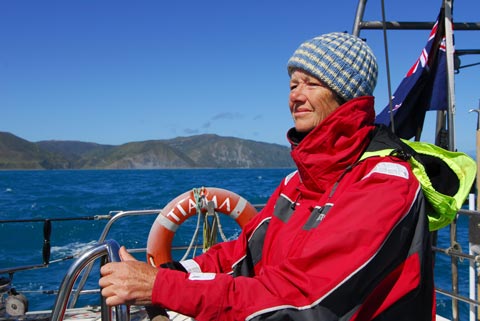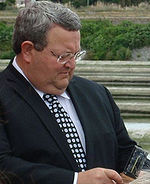
I’m really pleased to welcome Jeanette Fitzsimons to Hot Topic as a guest blogger. The environmentalist and former co-leader of the NZ Greens is on board the yacht Tiama, sailing out into the Tasman to protest against deep water oil exploration. She will be providing us with regular updates on the flotilla’s progress.
What a fabulous send off. A dozen kayakers, wearing penguin suits, lined up and waved us on our way as we left the harbour. Several small boats sailed with us. About 100 well wishers gathered on the wharf; speeches in support from Green and independent MPs, oil free Wellington, Ora Taiao (climate and health council); two sails spread out on the ground covered with signatures and messages in support of our mission; and home baked cookies and chocolate cake delivered to the wharf by old friends.
I’m on the Tiama, a 50 ft cutter-rigged steel sloop built by skipper Henk, veteran of many campaigns. With us is Bunny from Greenpeace, Barclay who will make a sailor of me by the end of the voyage, and Pascale from France with the camera and the laptop. Later tonight we will pick up two more before heading out to the site 120 miles west of Raglan where Texas oil giant Anadarko has been invited, nay begged, even subsidised, by our government to try a repeat exercise of what went wrong in the Gulf of Mexico in 2010.
The Baltazar is sailing with us, skippered by Andy Whittaker, and we plan to rendezvous on Saturday on site with four other boats which left from Auckland, Bay of Islands and Bluff.
Anadarko says that coming out to their drilling site is dangerous. Yeah, right. Who’s causing the danger, drilling under 1500 m of water, knowing the very similar Macondo Prospect they part-owned in the Gulf of Mexico blew out, spewing 650,000 tonnes of oil?
If that happened here, it would take weeks for emergency clean up equipment to arrive from overseas. While we waited the oil would spread, contaminating our coast from Taranaki to the Hokianga and poisoning the whole marine web of life: including our fisheries, seabirds, whales, the Maui dolphin and coastal communities.
Continue reading “Westward Ho: With the Anadarko Flotilla – day one”

 A
A 
 What makes this event significant, is the role Arctic sea ice plays as a reflector of solar energy. Ice is white and therefore reflects a large part of incoming sunlight back out to space. But where there is no ice, dark ocean water absorbs most of the sunlight and thus heats up. The less ice there is, the more the water heats up, melting more ice. This
What makes this event significant, is the role Arctic sea ice plays as a reflector of solar energy. Ice is white and therefore reflects a large part of incoming sunlight back out to space. But where there is no ice, dark ocean water absorbs most of the sunlight and thus heats up. The less ice there is, the more the water heats up, melting more ice. This 